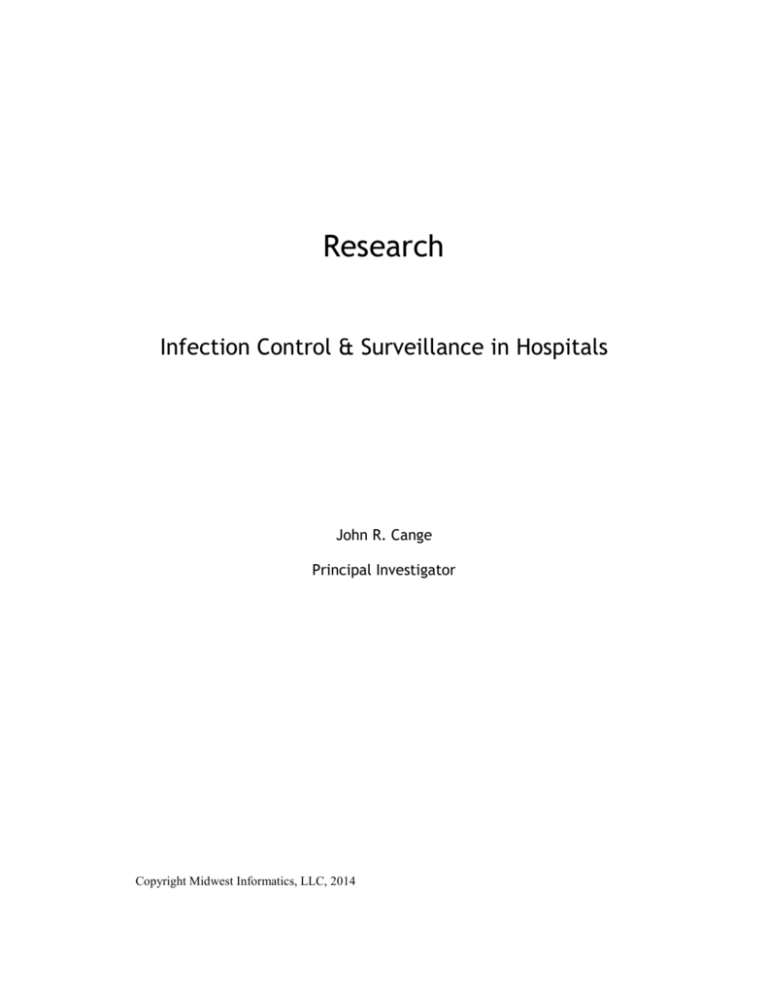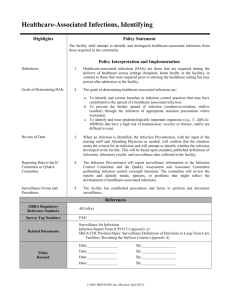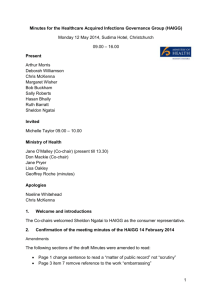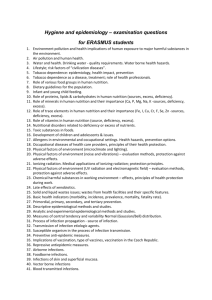Infection Control & Surveillance in Hospitals
advertisement

Research Infection Control & Surveillance in Hospitals John R. Cange Principal Investigator Copyright Midwest Informatics, LLC, 2014 INFECTION CONTROL & SURVEILLANCE 2 Abstract This paper summarizes the work being done to drive the identification, prevention, and prediction of healthcare associated infections (HAI), also known as nosocomial infections in hospital settings. A summary of recent successes and failures with reducing the major types of HAI interventions, and as well as a synopsis of recent HAI prevention efforts is also included. A description of the government and industry organizations that oversee infection surveillance and reporting provide historical and healthcare industry context. Keywords: healthcare associated infections, nosocomial infections INFECTION CONTROL & SURVEILLANCE 3 Infection Control & Surveillance in Hospitals One of the primary goals of the Centers for Disease Control and Prevention (CDC) and the Centers for Medicare and Medicaid Services (CMS) is to reduce the number of HAIs in the U.S. CMS’ goals for measurement and reporting HAI for fiscal year 2013 focused on 3 sources of HAI: central line-associated blood stream infections catheter-associated urinary tract infections, and surgical site infections. CMS, the CDC, and the World Health Organization (WHO) all share the goal of preventing infectious outbreaks. Literature Review In their study of real-time surveillance and decision support, Young and Stevenson (2008) estimated that 10% of American hospital patients (about 2 million per year) will acquire a clinically significant HAI. According to the mortality rates cited, these infections could result in 100,000 deaths per year. According to a study by Roberts et al.(2010), the cost of these infections total $4.5B per year. HAIs are one of the leading causes of death in the United States. Prior efforts to reduce the number of HAIs have tried to break the chain of transmission by removing the opportunistic bacteria or virus from the environment and by isolating the infected patients. Research into improving control and prevention of infections has been a continuing effort. According to Black (1996), nosocomial infections are difficult to remove from hospitals due to the: INFECTION CONTROL & SURVEILLANCE high prevalence of pathogens high prevalence of compromised hosts efficient mechanisms of transmission from patient to patient. 4 According to the Health.gov website (2014), the US Department of Health and Human Services (HHS) launched an Action Plan to Prevent Healthcareassociated Infections in 2009. The Action Plan set national targets for reducing specific infections and though HHS is accountable for change across the healthcare system, federal agencies actually have limited control. The Action Plan also established the model by which different government agencies would coordinate efforts at the federal level. The Plan recommends changes that address transparency, financial incentives, support of state and regional HAI prevention efforts, changes in safety culture, and mechanisms to engage stakeholders. As part of the Plan, the essential infrastructure required to stimulate change throughout the healthcare system was also implemented. According to the CMS.gov website (2014), CMS seeks to reduce the extra hospital days and treatment costs associated with these types of infections, as described in the Hospital Inpatient Prospective Payment System and Long-Term Care Hospital Prospective Payment System. HAI measure data are collected by the CDC via tools managed by the National Healthcare Safety Network (NHSN). Hospitals must enroll and complete NHSN training to comply with CMS Hospital Inpatient Quality Reporting (IQR) Program HAI requirements. The CDC requires that multiple users complete the required NHSN training, gain access to the NHSN tool for reporting, and submit data on a monthly basis. Hospitals must INFECTION CONTROL & SURVEILLANCE 5 adjust their guidelines and utilize CDC-provided report templates used and follow reporting protocols, as required. Individual hospitals establish or adjust their routines and practices with prevention in mind as the best way to control nosocomial infections. According to Black (1996), the most common nosocomial infection pathways are by direct person-to-person transmission between an infected patient, staff member, or visitor and non-infected patients; indirect transmission through equipment, supplies, and hospital procedures; or transmission through air. Nosocomial infections are generally caused by opportunistic infection types, particularly by: Enterococcus spp., including vancomycin-resistant enterococci (VRE) Escherichia coli Pseudomonas spp. Staphylococcus aureus, including methicillin-resistant strains (MRSA) Clostridium difficile In their paper on developing an automated early warning system, Mellmann et al. (2006), the common method used by hospitals to determine if an outbreak has occurred is to apply a few simple rules, such as the occurrence of 3 new cases of a pathogen within 2 weeks on the same ward. Hospitals generally focus, however, on a few pathogens and don’t often look at clusters of infections that span multiple wards or those associated with specialty services. Ideally, outbreak detection programs should use a wide array of data sources and consider multiple pathogens to be comprehensive and effective. INFECTION CONTROL & SURVEILLANCE 6 Young and Stevenson (2008) studied the use of claims information from administrative databases to help identify HAI outbreaks and noted a significant discrepancy between hospital and HMO-based systems in identifying patients who underwent central venous catheter insertion. Other studies have demonstrated that claims data alone are poor predictors of true infections. A well-designed automated surveillance system could easily integrate data from multiple sources to detect HAIs in all health care settings, including the outpatient arena. Sources of HAI Recent publications and papers describe some effective prevention and intervention efforts, as well as those that include ineffective or inconsistent results. The following section summarizes recent case studies for each of the 5 main sources or types of HAI. This information provides insight into the effectiveness and uncertainties of recent HAI surveillance and prevention programs. Central Line-Associated Bloodstream Infections. Mendel et al. (2014) reported in their study of central line-associated bloodstream infections (CLABSI) in a pediatric hematology/oncology population, the overall CLABSI rate fell from 9 infections per 1000 line days to zero at the conclusion of the study. At the study team's institution, an initiative that standardized blood culturing techniques, lab draw times, line care techniques, and provided physician and nurse education was able to eliminate CLABSI among pediatric hematology/oncology patients. Catheter-Acquired Urinary Tract Infections. Parry, Grant, and Sestovic (2013) studied how one hospital reduced catheter use by 50% and experienced a INFECTION CONTROL & SURVEILLANCE 7 70% reduction in catheter-acquired urinary tract infections (CAUTI) over a 36month period. Results varied by unit with improvements of as little as 4% (maternity) versus 74% (telemetry). Overall, urinary catheter use and CAUTI rates were reduced by the use of evidence-based interventions, such as the nursedirected catheter removal protocol, which was shown to lower catheter use rates and reduce infection rates. Surgical Site Infections. Lübbeke et al. (2013) showed that using a surgical safety checklist can result in significant reduction in postoperative surgical site infections (SSI), morbidity, and mortality. The hospital implemented a pre-surgery checklist to ensure proper safeguards were in place before the surgery began. Comparing pre-implementation to post-implementation periods: checklist use during 77 interventions prevented 1 reoperation for SSI, which was a 50% improvement. The number of unplanned returns to the operating room was reduced by 19%, though the unplanned returns to the ICU made only small improvements. The number of in-hospital deaths actually increased by 17%, though use of the checklist is not considered a causal agent. Ventilator-Associated Pneumonia. In a study of how guidelines can help prevent ventilator-associated pneumonia (VAP), Flodgren et al. (2013) noted the low quality of the evidence, which raises uncertainty about which interventions are most effective in changing professional behavior and in what contexts. However, educational interventions that are repeatedly administered over time and interventions employing specialized personnel have shown some positive results. INFECTION CONTROL & SURVEILLANCE 8 Clostridium difficile infection. In a study by Novak-Weekley et al. (2010), it was then noted that the incidence of Clostridium difficile Infection (CDI) has risen almost 300% in the United States in the last 10 years, emphasizing the need for better interventions, including more rapid and accurate tests for CDI. In a computer simulation developed by Rubin et al. (2013) using existing clinical data, six interventions were introduced - both alone and "bundled" together: aggressive C. difficile testing; isolation and treatment of symptomatic patients; improved adherence to hand hygiene and contact precautions; improved use of soap and water for hand hygiene; improved environmental cleaning. The "bundled" intervention involved better hand hygiene, better isolation of infected patients, and better treatment of suspected cases and was found to be more likely to reduce CDI than any of the other interventions alone. As described by Alcala´ et al. (2012) in their paper on the under-diagnosis of CDI in Spain, the Spanish Clostridium difficile Study Group performed C. difficile cultures on all stool specimens sent to a series of laboratories in Spain on a single day. The specimens were cultured and characterized at a central reference laboratory. Results: a total of 807 specimens from 118 laboratories were collected, covering 75.4% of the Spanish population. The estimated rate of hospital-acquired CDI was .24% during this time. However, 2 of every 3 episodes went undiagnosed or were misdiagnosed, owing to non-sensitive diagnostic tests (19.0%) or lack of recognition (47.6%; mostly young people or non-hospitalized patients). It was found, however, that all CDI strains were fully susceptible to metronidazole and vancomycin. Consequently, the Spanish electronic medical INFECTION CONTROL & SURVEILLANCE 9 records systems were programmed to recommend these medications when the reference lab provided positive CDI results. Discussion Several mathematical/statistical models and methods have been used to identify, prevent, and predict HAI. A brief review of the different methods demonstrates that no one method or model has been shown to be effective and effectiveness varied by the type of infection/outbreak and whether the goal was to identify and prevent the spread of the infection or to predict it based on environmental factors. Outbreak Identification/Prevention. In a retrospective cohort study by Huang et al. (2009) at Brigham Women’s Hospital (BWH), the organization used the World Health Organization’s (WHO) WHONET-SaTSan laboratory information software to identify clusters of infections using a space-time permutation scan statistic. This method defines the space or location in which the pathogen was identified, e.g. within 5 miles. The method then describes a cylinder that will result when the space is multiplied by the time, from 1 to 7 days. The resulting cylinder contains all of the identified cases that have occurred within that space and during the 1 to 7 day bounds. The number of cylinders will vary and cylinders may overlap as they are centered on patient medical information from over-the-counter drug sales at pharmacies, nurse hotline calls, regular physician visits, ER department visits, ambulance dispatches, or lab test results. The WHO application considered the likelihood of clusters occurring by chance as being less than once per year. For MRSA and VRE clusters, the WHONET- INFECTION CONTROL & SURVEILLANCE 10 generated clusters were compared to those identified by BWH’s Infection Control program’s existing rule-based criterion of 3 occurrences in 2 weeks within a single ward. Current detection methods involve case counting and subjective judgments on whether a cluster is occurring in a ward. Generally, these rule-based clusters trigger precautionary measures across the hospital ward, including alerts sent to nursing and physician leadership, weekly screening and culture collection from all ward patients, use of gloves for all patient contact, and the potential need to disinfect rooms, surfaces, and devices. These interventions often continue until no new cases are identified over a 4 week period or until all cases are discharged from the ward. Due to the resource-intensive nature of these measures, the costs of false-positives are very high. The WHONET-SaTScan outperformed traditional infection control surveillance in 3 ways. This approach has the potential to be more comprehensive than infection control resources; reduce the number of false-positives identified by the current, rules-based infection control system; and it identifies events that are statistically unusual and may represent an opportunity for intervention. Statistical methods like those utilized in the WHONET-SaTSan application can be run every day to identify occurrences of pathogens as quickly as possible. The statistical and probabilistic nature of the space-time scan adjusts for “normal” (random) appearance of such pathogens in a hospital. The number of false positives is almost 0 in a space-time permutation scan, which indicates that any new, non-random clusters deserve attention. INFECTION CONTROL & SURVEILLANCE 11 From an epidemiological standpoint, the WHONET tool could be expanded to include any number of hospitals and medical groups to take a broader view of the overlapping cylinders. This approach may also improve the ability to better identify the location of the first appearance of a nosocomial infection before it can become an outbreak. Outbreak Prediction. Though the WHONET statistical method may prove to be better at identifying infection clusters and potential outbreaks, Buczak, Koshute, Babin, Feighner, and Lewis (2012) described a rules-based model they used to detect outbreaks of dengue fever which experienced a 68% success rate as much as 4 weeks in advance. This data-driven model looks at multiple data sources, such as telephone calls to physicians, physician visits, ER department visits, lab test requests, lab test results, and drug prescriptions. The model then constructs an association tree that is trained to build rules and classifiers. The ‘best’ classifier is chosen by using validation data and looking at the model’s predictive power. They extracted relationships between clinical, meteorological, climatic, and socio-political data from Peru. The relationships are in the form of rules and the best set of rules is automatically chosen and forms a classifier. That classifier is then used to predict future dengue incidence as either HIGH (outbreak) or LOW (no outbreak). Results: The automated method built three different fuzzy association rule models. The first two weekly models predicted dengue incidence three and four weeks in advance, respectively. The third prediction encompassed a four-week period, used previously unused test data for the period 4-7 weeks from time of prediction and yielded a positive predictive INFECTION CONTROL & SURVEILLANCE 12 value of 0.686, a negative predictive value of 0.976, a sensitivity of 0.615, and a specificity of 0.982. Chang et al. (2011) developed a scoring system to predict HAI, derived from Logistic Regression (LR) and simultaneously validated by Artificial Neural Networks (ANN). This study looked at 16 variables extracted from their EHR and fed into ANN and LR models. This method demonstrated ~97% accuracy in identifying internal infections and 87% success with external infections. Conclusions and Future Study The ability to identify and prevent nosocomial infections is critical, but the best methods for doing so for a discrete HAI type are sometimes inconsistent and ineffective. In a recent study by Kahn and Battles (2014), researchers indicate good progress and identify lessons learned. By taking a comprehensive approach to surveillance, identifying outbreaks is greatly improved. Use of statistical, artificial neural networks and rules-based systems have all had recent successes. Advances have been made in preventing several of the core types of nosocomial infections, though research and new interventions need to attempted and studied on a continuing basis. Advances in statistical analysis tools, like the WHONETSaTSan application, provides a way to identify nosocomial infections more accurately and to potentially identify the sources of infections more quickly. Further study into the best-practice methods and models for identifying, treating, preventing, and predicting HAI outbreaks is needed. INFECTION CONTROL & SURVEILLANCE 13 References Alcala´ L., et al. (2012). The undiagnosed cases of Clostridium difficile infection in a whole nation: where is the problem? Clinical Microbiology & Infection. Jul2012, Vol. 18 Issue 7, pE204-E213. 10p. Black, J.G. (1996). Microbiology. Principles and Applications. Third Edition. Prentice Hall. Upper Saddle River, New Jersey. pp. 436-443. Buczak A., Koshute P., Babin S., Feighner B., Lewis S. (2012). A data-driven epidemiological prediction method for dengue outbreaks using local and remote sensing data. BMC Medical Informatics & Decision Making, 12(1), 124-143. doi:10.1186/1472-6947-12-124 Centers for Medicare & Medicaid Services. (2012) Hospital-Acquired Conditions (HAC) in Acute Inpatient Prospective Payment System (IPPS) Hospitals. Retrieved from http://www.cms.gov/Medicare/Medicare-Fee-for-ServicePayment/HospitalAcqCond/downloads/HACFactSheet.pdf Chang Y-J., Yeh M-L., Li Y-C., Hsu C-Y., Lin C-C., et al. (2011) Predicting Hospital-Acquired Infections by Scoring System with Simple Parameters. PLoS ONE 6(8): e23137. doi:10.1371/journal.pone.0023137 Flodgren G., Conterno LO., Mayhew A., Omar O., Pereira CR., Shepperd S. (2013) Interventions to improve professional adherence to guidelines for prevention of device-related infections. Cochrane Database Syst Rev. Mar 28;3:CD006559. doi: 10.1002/14651858.CD006559.pub2 INFECTION CONTROL & SURVEILLANCE 14 Health.gov. (2013) National Action Plan to Prevent Health Care-Associated Infections: Road Map to Elimination. Retrieved from http://www.health.gov/hai/pdfs/hai-action-plan-acute-care-hospitals.PDF Huang S., Yokoe D., Stelling J., Placzek H., Kulldorff M., et al. (2010) Automated Detection of Infectious Disease Outbreaks in Hospitals: A Retrospective Cohort Study. PLoS Med 7(2): e1000238. doi:10.1371/journal.pmed.1000238. Kahn K., Battles J. (2014) Introduction: Taking National Action to Prevent and Eliminate Healthcare–associated Infections. Medical Care, 52(2 Suppl 1), S1-S3. doi:10.1097/MLR.0000000000000083 Kulldorff M., Heffernan R., Hartman J., Assunção R., Mostashari F. (2005) A Space–Time Permutation Scan Statistic for Disease Outbreak Detection. Plos Medicine, 2(3), 216-224. doi:10.1371/journal.pmed.0020059 Lübbeke A., Hovaguimian F., Wickboldt N., Barea C., Clergue F., Hoffmeyer P., Walder B. (2013) Effectiveness of the surgical safety checklist in a high standard care environment. Medical Care, 51(5), 425-429. doi:10.1097/MLR.0b013e31828d1489 Mellmann A., Friedrich A., Rosenkotter N., Rothganger J., Karch H., et al. (2006) Automated DNA sequence-based early warning system for the detection of methicillin-resistant Staphylococcus aureus outbreaks. PLoS Med 3: e33. doi:10.1371/journal.pmed.0030033 Mendel P., Siegel S., Leuschner K., Gall E., Weinberg D., Kahn K. (2014) The National Response for Preventing Healthcare-associated Infections: INFECTION CONTROL & SURVEILLANCE 15 System capacity and sustainability for improvement. Medical Care, 52(2 SUPPL.1), S83-S90. doi:10.1097/MLR.0000000000000032 Novak-Weekley S., Marlowe E., Miller J., Cumpio J., Nomura J., Vance P., et al. (2010) Clostridium difficile testing in the clinical laboratory by use of multiple testing algorithms. Journal Of Clinical Microbiology, 48(3), 889893. doi:10.1128/JCM.01801-09 Parry M., Grant B., Sestovic M. (2013) Successful reduction in catheterassociated urinary tract infections: focus on nurse-directed catheter removal. American Journal Of Infection Control, 411178-1181. doi:10.1016/j.ajic.2013.03.296 Roberts, R., Schabowski, S., Ahmad, I., Scott, R., Hota, B., et al. (2010). Costs Attributable to Healthcare-Acquired Infection in Hospitalized Adults and a Comparison of Economic Methods. Medical Care, 48(11), 1026-1035. doi:10.1097/MLR.0b013e3181ef60a2 Young J., Stevenson K. (2008) Real-time surveillance and decision support: Optimizing infection control and antimicrobial choices at the point of care. American Journal Of Infection Control, 36(3 SUPPL.), S67-S74. doi:10.1016/j.ajic.2007.12.001






